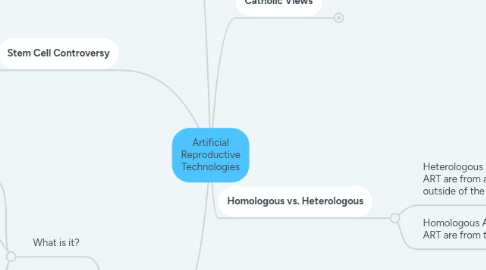
1. Social Concerns
1.1. A problem to treat children as property to which adults have rights
1.2. To define family in terms of contractual rights neglects relevance of kinship bonds
1.3. Displaces moral evaluation of means to one’s reproductive ends
1.4. What is the duration of parental responsibility i.e. re: gamete donors?
1.5. Family bonds governed by rights and ownership
2. Stem Cell Controversy
2.1. The former is controversial since it has involved, historically, destroying the embryo to obtain the stem cells
2.2. Destroying human life and using it as means rather than treating it as an end
3. Cloning
3.1. What is it?
3.1.1. An egg cell or oocyte has its nucleus removed
3.1.2. A somatic cell’s nucleus is removed from the somatic cell and inserted into the enucleated egg cell
3.1.3. This cell undergoes cell division to the point of becoming an embryo which is then inserted into a woman’s womb to develop into a fetus
3.1.4. Resulting individual is virtually genetically identical to that of the nuclear donor
3.2. Moral Concerns
3.2.1. Lack of respect for the natural relationship between sex and reproduction?
3.2.2. Lack of respect for the dignity of the child, human dignity, human individuality?
4. Catholic Views
4.1. Donum vitae emphasizes:
4.1.1. -The rights and welfare of embryos
4.1.2. -Integral connections between sex, marriage, and parenthood
4.1.3. -Integral connections between sex, marriage, and parenthood
4.2. In ART, there is separation of sex, love and procreation in both homologous and heterologous artificial reproductive measures are wrong
4.2.1. Vatican limits homologous methods also since:
4.2.2. “Fertilization achieved outside of the bodies of the couple is deprived of the meanings and values expressed in the language of the body and in the union of the human persons.”
5. Homologous vs. Heterologous
5.1. Heterologous ART – the gametes used in ART are from at least one other party outside of the couple
5.1.1. E.g. use of donor egg or donor sperm cells or both
5.2. Homologous ART – the gametes used in ART are from the couple themselves
5.2.1. E.g. surrogate motherhood, artificial insemination

